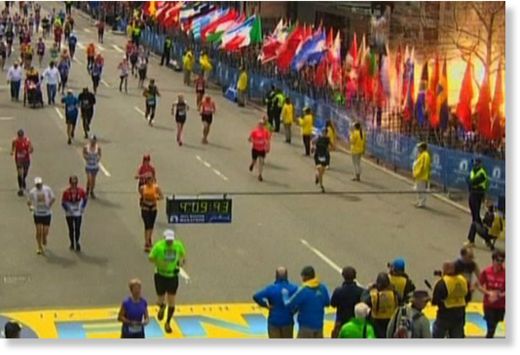
© NBC via ReutersAn image taken from video shows an explosion near the finish line
Investigators said the two Boston Marathon bombs were triggered by long-range remote controls for toy cars - a more sophisticated design than originally believed - bolstering a theory that the older suspect received bomb-making guidance on his six-month trip to Russia last year.
Tamerlan Tsarnaev, who died in a shootout with police last week, "more than likely got some instruction in Dagestan," a federal law enforcement official said Wednesday.
The official said investigators continued to believe that Tsarnaev, 26, and his brother, Dzhokhar, 19, were radicalized in the U.S., and that no foreign terrorist group orchestrated the plot.
Nevertheless, the CIA revealed Wednesday that it had asked the FBI and other federal agencies to put Tamerlan Tsarnaev on the terrorism watch list in October 2011 after receiving information from Russia. His name was not placed on a no-fly list, but it was circulated to various intelligence and domestic security agencies.
The information the CIA received "was nearly identical to the information the FBI received in March 2011" from Russia, one official said - unspecific allegations that he had become an Islamic extremist.
The CIA shared all the information provided by the foreign government including two possible dates of birth, his name and a possible name variant as well, an official said.
FBI and Russian security services have been conducting interviews separately in the Dagestan area since the Tsarnaev brothers became suspects in the bombings last week, according to a federal law enforcement official. The agencies are talking to Tsarnaev family members, including the father of the brothers.
The officials asked not to be identified because they were not authorized to discuss the investigation.
Further suggesting that Tamerlan Tsarnaev's Russia trip played a role, Secretary of State John F. Kerry told reporters Wednesday in Brussels that the elder suspect "learned something where he went, and he came back with a willingness to kill people."
A joint FBI and Department of Homeland Security intelligence bulletin sent to state and local law enforcement Tuesday night suggested that the bombs' triggering mechanism was more sophisticated than previously thought.
"The sophistication of the explosive devices is similar to what you might find on a battlefield, and I am concerned there is a person out there, either in the Chechen region or in the United States, who trained him," Rep. Michael McCaul, R-Texas, chairman of the House Homeland Security Committee, said in a statement.
"For anyone to rule out a foreign connection at this time, I think is highly premature," he said.
Dzhokhar Tsarnaev, who was captured Friday and is still being treated for gunshot wounds, has told investigators that he and his older brother were operating alone, and that they had received no training or support from outside terrorist groups.
The renewed focus by investigators on the Russia trip has members of Congress asking why U.S. authorities didn't further scrutinize Tamerlan Tsarnaev after he returned last year. Officials shed light on that chain of events Wednesday.
When Tamerlan Tsarnaev flew into New York's John F. Kennedy International Airport after his Russia trip, his name was flagged in a database that matches names on passenger manifests with lists of suspected extremists and others who may merit law enforcement attention.
But he was not pulled aside by U.S. Customs agents because "he wasn't high on the priority list," a senior U.S. counterterrorism official said. The FBI had cleared the case more than a year before.
In 2011, the FBI investigated Tsarnaev after the Russian government said he had become an Islamic radical. The FBI said it found no evidence to support that warning.
The FBI "checked U.S. government databases and other information to look for such things as derogatory telephone communications, possible use of online sites associated with the promotion of radical activity, associations with other persons of interest, travel history and plans, and education history," the bureau said in a statement.
It was unclear Wednesday whether Customs officials alerted the FBI when Tsarnaev left the U.S., or when he returned.
The intelligence bulletin on the bombs said each one "likely incorporated an electrical fusing system using components from remote control toy cars."
The bombs used "an electronic speed control" as a switch, and "sub-C rechargeable battery packs at the power source," read the bulletin, according to an official.
Both pressure-cooker bombs used a low-explosive mixture that incorporated nitrate and perchlorate-based oxidizers, the bulletin said. Investigators don't know whether the explosive was purchased that way or was mixed from different sources, including gun powder from fireworks purchased by Tamerlan Tsarnaev.
Pressure-cooker bomb recipes are available on the Internet. Officials said the brothers may have gotten theirs from Inspire, a magazine put out by al-Qaida's Yemen affiliate.
Bomb experts said it was unlikely, though not impossible, that the brothers successfully built and detonated the two bombs without outside help and practice, as Dzhokhar Tsarnaev has told his interrogators.
Dave Williams, a retired FBI forensic bomb technician, theorized that Tamerlan Tsarnaev received some kind of counseling in Russia on the best types of bombs to build and then went online for specific instructions.
The bombs themselves required minimal expertise to build, said Williams, who worked on the investigations of the 1993 World Trade Center bombings and the Oklahoma City bombing.
"It was sophisticated enough to work," he said. "You don't need a lot of education; you don't need an electronic education."
Isn't it just as likely - or far more likely- that former US military personal now working in the Private Sector, such as Blackwater/Academi- fabricated the bomb? Certainly among the paramilitary types standing around at the marathon finish line, one of them would have the "sophistication" to assemble such a weapon.